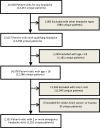Does health information exchange reduce unnecessary neuroimaging and improve quality of headache care in the emergency department?
- PMID: 22648609
- PMCID: PMC3614141
- DOI: 10.1007/s11606-012-2092-7
Does health information exchange reduce unnecessary neuroimaging and improve quality of headache care in the emergency department?
Abstract
Background: Health information exchange (HIE) is advocated as an approach to reduce unnecessary testing and improve quality of emergency department (ED) care, but little evidence supports its use. Headache is a specific condition for which HIE has theoretical benefits.
Objective: To determine whether health information exchange (HIE) reduces potentially unnecessary neuroimaging, increases adherence with evidence-based guidelines, and decreases costs in the emergency department (ED) evaluation of headache.
Design: Longitudinal data analysis
Subjects: All repeat patient-visits (N = 2,102) by all 1,252 adults presenting with headache to a Memphis metropolitan area ED two or more times between August 1, 2007 and July 31, 2009.
Intervention: Use of a regional HIE connecting the 15 major adult hospitals and two regional clinic systems by authorized ED personnel to access the patient's record during the time period in which the patient was being seen in the ED.
Main measures: Diagnostic neuroimaging (CT, CT angiography, MRI or MRI angiography), evidence-based guideline adherence, and total patient-visit estimated cost.
Key results: HIE data were accessed for 21.8 % of ED patient-visits for headache. 69.8 % received neuroimaging. HIE was associated with decreased odds of diagnostic neuroimaging (odds ratio [OR] 0.38, confidence interval [CI] 0.29-0.50) and increased adherence with evidence-based guidelines (OR 1.33, CI 1.02-1.73). Administrative/nursing staff HIE use (OR 0.24, CI 0.17-0.34) was also associated with decreased neuroimaging after adjustment for confounding factors. Overall HIE use was not associated with significant changes in costs.
Conclusions: HIE is associated with decreased diagnostic imaging and increased evidence-based guideline adherence in the emergency evaluation of headache, but was not associated with improvements in overall costs. Controlled trials are needed to test whether specific HIE enhancements to increase HIE use can further reduce potentially unnecessary diagnostic imaging and improve adherence with guidelines while decreasing costs of care.
Figures
Comment in
-
Connecting patients, providers, and payers improves quality, safety and efficiency.J Gen Intern Med. 2013 Feb;28(2):167-8. doi: 10.1007/s11606-012-2295-y. J Gen Intern Med. 2013. PMID: 23288375 Free PMC article. No abstract available.
References
-
- American College of Emergency Physicians Health information technology. Ann Emerg Med. 2008;52:595. - PubMed
-
- Walker J, Pan E, Johnston D, Adler-Milstein J, Bates DW, Middleton B. The value of health care information exchange and interoperability. Health Aff (Millwood). 2005;Suppl Web Exclusives:W5-10-W5-8. - PubMed
Publication types
MeSH terms
LinkOut - more resources
Full Text Sources
Medical


